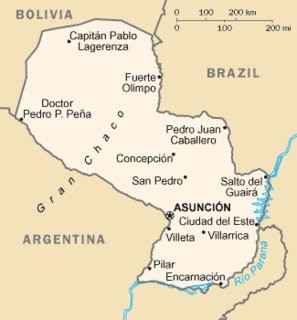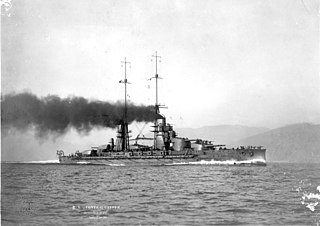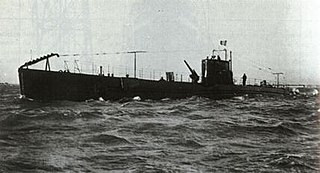
Grenada is an island country located between the Caribbean Sea and Atlantic Ocean, north of Trinidad and Tobago. It is located at 12°07′N61°40′W. There are no large inland bodies of water on the island, which consists entirely of the state of Grenada. The coastline is 121 km long. The island has 15 constituencies and speaks English and Grenadian Creole. It is volcanic in origin and its topography is mountainous.

Paraguay is a country in South America, bordering Brazil, Argentina and Bolivia. The Paraguay River divides the country into strikingly different eastern and western regions. Both the eastern region and the western region gently slope toward and are drained into the Paraguay River, which separates and unifies the two regions. With the Paraneña region reaching southward and the Chaco extending to the north, Paraguay straddles the Tropic of Capricorn and experiences both subtropical and tropical climates.

Cirrus is a genus of high cloud made of ice crystals. Cirrus clouds typically appear delicate and wispy with white strands. Cirrus are usually formed when warm, dry air rises, causing water vapor deposition onto rocky or metallic dust particles at high altitudes. Globally, they form anywhere between 4,000 and 20,000 meters above sea level, with the higher elevations usually in the tropics and the lower elevations in more polar regions.

Kuma is a village located in Kuma District, Kumamoto Prefecture, Japan.

The Atacama Large Millimeter/submillimeter Array (ALMA) is an astronomical interferometer of 66 radio telescopes in the Atacama Desert of northern Chile, which observe electromagnetic radiation at millimeter and submillimeter wavelengths. The array has been constructed on the 5,000 m (16,000 ft) elevation Chajnantor plateau - near the Llano de Chajnantor Observatory and the Atacama Pathfinder Experiment. This location was chosen for its high elevation and low humidity, factors which are crucial to reduce noise and decrease signal attenuation due to Earth's atmosphere. ALMA provides insight on star birth during the early Stelliferous era and detailed imaging of local star and planet formation.

The Cerro Tololo Inter-American Observatory (CTIO) is an astronomical observatory located on Cerro Tololo in the Coquimbo Region of northern Chile, with additional facilities located on Cerro Pachón about 10 kilometres (6.2 mi) to the southeast. It is approximately 80 kilometres (50 mi) east of La Serena, where support facilities are located. The site was identified by a team of scientists from Chile and the United States in 1959, and it was selected in 1962. Construction began in 1963 and regular astronomical observations commenced in 1965. Construction of large buildings on Cerro Tololo ended with the completion of the Víctor Blanco Telescope in 1974, but smaller facilities have been built since then. Cerro Pachón is still under development, with two large telescopes inaugurated since 2000, and one in the early stages of construction

The Conte di Cavour–class battleships were a group of three dreadnoughts built for the Royal Italian Navy in the 1910s. The ships were completed during World War I, but none saw action before the end of hostilities. Leonardo da Vinci was sunk by a magazine explosion in 1916 and sold for scrap in 1923. The two surviving ships, Conte di Cavour and Giulio Cesare, supported operations during the Corfu Incident in 1923. They were extensively reconstructed between 1933 and 1937 with more powerful guns, additional armor and considerably more speed than before.
The Combined Array for Research in Millimeter-wave Astronomy (CARMA) was an astronomical instrument comprising 23 radio telescopes, dedicated in 2006. These telescopes formed an astronomical interferometer where all the signals are combined in a purpose-built computer to produce high-resolution astronomical images. The telescopes ceased operation in April 2015 and were relocated to the Owens Valley Radio Observatory for storage.

Hypericum tortuosum is a species of flowering plant in the genus Hypericum. It is found only in Socotra, Yemen, where it is endemic. The species is an apomorphic relative of the other Socotran species in Hypericum sect. Triadenioides and is most closely related to Hypericum scopulorum. Its natural habitats are subtropical or tropical dry forests and subtropical or tropical dry shrubland.

The Gueydon-class cruiser was a three-ship class of armored cruisers built in the first decade of the twentieth century for the French Navy.

HDMS Niels Juel was a training ship built for the Royal Danish Navy between 1914 and 1923. Originally designed before World War I as a monitor, construction was slowed by the war and she was redesigned as a training cruiser. Completed in 1923 she made training cruises to the Black and Mediterranean Seas, South America and numerous shorter visits to ports in northern Europe. The ship often served as a flagship and occasionally was used as a royal yacht for visits to overseas possessions and other countries.

Hypericum aegypticum is a species of flowering plant of the St. John's wort family (Hypericaceae) which is native to the Eastern Mediterranean. It was described by Carl Linnaeus in the second volume of his Species Plantarum in 1753, who named it after Egypt despite it not being distributed there. The plant is commonly known as shrubby St. John's wort or Egyptian St. John's wort in English. Like other members of section Adenotrias, it is found among limestone rocks in coastal areas. While it has been evaluated as threatened on the island of Malta, the species has no legal protections.

The Argonauta-class submarine was the first sub-class of the 600 Series of coastal submarines built for the Regia Marina during the 1930s. Some of these boats played a minor role in the Spanish Civil War of 1936–1939 supporting the Spanish Nationalists. Of the seven boats built in this class, only a single one survived the Second World War.
The Bandiera-class submarines were built for the Regia Marina during the late 1920s. They played a minor role in the Spanish Civil War of 1936–1939 supporting the Spanish Nationalists.
The Mameli-class submarine was one of the first classes of the submarines to be built for the Regia Marina after the First World War. Some of these boats played a minor role in the Spanish Civil War of 1936–1939 supporting the Spanish Nationalists. Of the four boats built in this class, all but one survived the Second World War.
Mont Niénokoué is an inselberg in the Taï National Park in the Bas-Sassandra District of south-west Côte d'Ivoire. Its summit is 396 meters above sea level and 216 meters above the surrounding terrain. Its base circumference is about 40 kilometers.

Afrosciadium abyssinicum, synonym Peucedanum abyssinicum, is a member of the carrot family, Apiaceae. It is native to Ethiopia, where it grows at high elevations.

Afrosciadium articulatum, synonym Peucedanum articulatum, is a member of the carrot family, Apiaceae. It is native to northern Malawi.

Afrosciadium caffrum is a member of the carrot family, Apiaceae. It is a perennial tuberous herb native to subtropical regions in eastern South Africa.

Afrosciadium magalismontanum is a member of the carrot family, Apiaceae. It is a perennial tuberous herb native to subtropical regions in eastern South Africa and Eswatini. It has a tall, narrow stem which divides into multiple evenly-spaced branches near the top, with each branch sporting a cluster of small yellow flowers at its end.
















